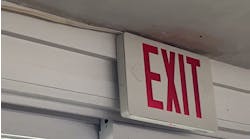Type TC-ER cable complies with the crush and impact requirements of metal-clad cable. It can be used when dropping out of cable tray to equipment or devices, and also where dropping from tray to tray.
The intent of Sec. 336.10(7) of the 2014 National Electrical Code (NEC), and its corresponding Exception, is to make it clear that cable with only a TC rating cannot be run unprotected outside a raceway or cable tray. There has been some confusion as to whether Type TC cable can drop from tray to tray for distances up to 6 ft without protection because it is all one “tray system.” However, the NFPA has made it clear that this is not the case.
This creates some problems for us though. There’s not a UL or other standard requirement that requires all TC cable to be -ER rated. Consequently, large cable manufacturers have a mixture of TC and TC-ER cable. Finding any single manufacturer that makes all TC-ER cable is impossible at this time. This means you must be very careful before purchasing this type of cable and examine all product information with a keen eye.
It’s relatively easy to find -ER rated cables in sizes No. 8 AWG and larger. However, the smaller sizes (less than or equal to No. 10 AWG) can be more difficult to locate in the market. So, as a designer, what are you supposed to do?
First do your homework, and try to find a manufacturer that makes -ER cable in all sizes and all conductor counts. The only other thing that you can do is design the system to physically protect the TC cables when dropping from tray to tray or from tray to equipment.
I’d venture to say in most industrial locations this rule is being violated today. Multi-conductor control cables — sizes No. 14 AWG through No. 10 AWG — are routinely dropped from tray to tray as well as from tray to equipment — such as motor control centers and switchgear — unprotected. And, not all of these cable drops use –ER rated cable. In the same vein, I’m sure there are Type TC cables in larger sizes still being used in this manner.
© 2015 Fluor Corporation. All Rights Reserved.


